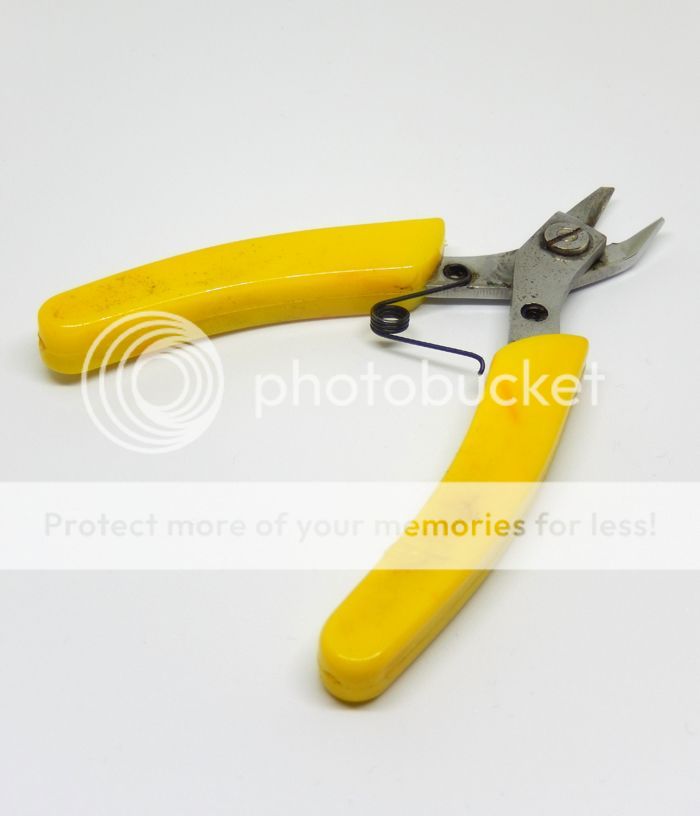Some silversmithing tools need to be hefty, to have some weight to them, to allow them to do the job they need to do. Others are able to combine some strength with deceptive delicacy.
I have a lot of pliers, all around 10 or 11 centimetres (4 or 5 inches) long, all collected piecemeal and utilised with varying degrees of success - many are used regularly but some languish in a "spare toolbox" and are tools of last resort.
A while ago I treated myself to a set of mini pliers, wrapped up tidily in their own case. I was intrigued to find out what quality they were and if they served any real purpose other than, well, being small and so more convenient to store.

The pliers are indeed mini, measuring around 8 cm (3 inches) each, and this decrease in size is felt in the handle more than elsewhere. But the heads of the pliers (round-, needle-, and flat-nosed and one side cutter) are all as well-formed as any other plier in a comparable (budget, in this case) price range and, while obviously a little smaller than a typical version, are still usable and effective.
The handles are well-shaped but their smaller length makes it harder to use them as comfortably as typically-sized pliers - I find with the latter much of my hand works the tool, whereas with the smaller version that action is more confined to the first two fingers.

However, for quick fixes and repairs, for times when you've packed everything away but really need a tool that's easy to lay your hands on, then this set is neat and ideal. The pliers also well-sized for working with very small items. For prolonged work I would find them a little tiring and fiddly and probably wouldn't choose them over larger sized tools, if they were easily available.
If you're just starting out or if you fancy smaller tools for more delicate work, then mini pliers may well be worth trying. Buying a set of pliers is a handy way to get the most used tools for simple jewellery making and these are usable, portable, and useful. I've made earrings and necklaces with this set and found the pliers and cutter excellent with very delicate sterling silver wire and tiny gemstones.
I'm not one to have superfluous tools ("spare toolbox" aside) but useful tools, even if they're near copies of other tools, will find a place in my main toolbox every time.
~~~~
Please note: this post contains no affiliate links and I have no connection with any manufacturer or retailer of jewellery tools.
I have a lot of pliers, all around 10 or 11 centimetres (4 or 5 inches) long, all collected piecemeal and utilised with varying degrees of success - many are used regularly but some languish in a "spare toolbox" and are tools of last resort.
A while ago I treated myself to a set of mini pliers, wrapped up tidily in their own case. I was intrigued to find out what quality they were and if they served any real purpose other than, well, being small and so more convenient to store.

The pliers are indeed mini, measuring around 8 cm (3 inches) each, and this decrease in size is felt in the handle more than elsewhere. But the heads of the pliers (round-, needle-, and flat-nosed and one side cutter) are all as well-formed as any other plier in a comparable (budget, in this case) price range and, while obviously a little smaller than a typical version, are still usable and effective.
The handles are well-shaped but their smaller length makes it harder to use them as comfortably as typically-sized pliers - I find with the latter much of my hand works the tool, whereas with the smaller version that action is more confined to the first two fingers.

However, for quick fixes and repairs, for times when you've packed everything away but really need a tool that's easy to lay your hands on, then this set is neat and ideal. The pliers also well-sized for working with very small items. For prolonged work I would find them a little tiring and fiddly and probably wouldn't choose them over larger sized tools, if they were easily available.
If you're just starting out or if you fancy smaller tools for more delicate work, then mini pliers may well be worth trying. Buying a set of pliers is a handy way to get the most used tools for simple jewellery making and these are usable, portable, and useful. I've made earrings and necklaces with this set and found the pliers and cutter excellent with very delicate sterling silver wire and tiny gemstones.
I'm not one to have superfluous tools ("spare toolbox" aside) but useful tools, even if they're near copies of other tools, will find a place in my main toolbox every time.
~~~~
Please note: this post contains no affiliate links and I have no connection with any manufacturer or retailer of jewellery tools.


